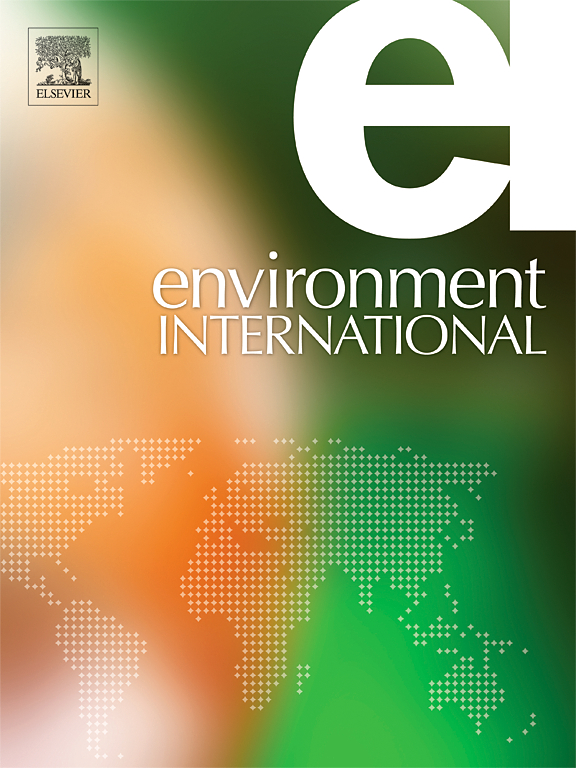加州住宅空调和社会脆弱性对热相关住院的影响
IF 10.3
1区 环境科学与生态学
Q1 ENVIRONMENTAL SCIENCES
引用次数: 0
摘要
缺乏进入凉爽空间的途径被认为是热脆弱性的关键决定因素。然而,对获得制冷对热健康结果的调节作用的评估通常使用住宅空调(AC)普及率的空间粗略估计。本文估计了加州27个城市1582个邮政编码区(zcta)城市间和城市内空调拥有量的模式,利用结果评估空调与社会脆弱性之间的协变,并研究空调患病率和社会脆弱性如何改变极端高温与发病率之间的关联。我们的方法结合了人口普查记录、疾病预防控制中心社会脆弱性指数(SVI)、气象变量以及加州卫生保健获取和信息部2012-2019年温暖季节的住院情况。我们首先构建了个体和zcta水平的住宅AC患病率估计,然后我们将其与大都市区域之间和内部的SVI进行比较,并使用时空分层病例交叉设计和条件泊松回归模型分别评估其对全因和原因特异性发病率的影响。我们发现AC患病率在全州范围内与社会脆弱性呈弱正相关(r = 0.15),在城市范围内呈弱负相关(r = −0.25)。我们发现了AC患病率对极端高温和全因相关性的影响改变的证据(低AC的RR为1.04(1.03,1.05),高AC的RR为1.01(1.00,1.02)),以及一些特定原因的住院治疗(例如,热相关疾病:低AC的RR为1.42(1.32,1.52),高AC的RR为1.21(1.11,1.32))。重要的是,我们发现住宅空调减少-但不能消除-不利的热健康结果的风险。本文章由计算机程序翻译,如有差异,请以英文原文为准。
The effects of residential air conditioning and social vulnerability on heat-related hospitalizations in California
Lack of access to cool spaces is considered to be a key determinant of heat vulnerability. However, assessments of the moderating effect of access to cooling on heat health outcomes have typically used spatially coarse estimates of residential air conditioning (AC) prevalence. Here we estimate patterns of inter- and intra-urban AC ownership across 1,582 zip code tabulation areas (ZCTAs) in 27 California cities, use the results to assess the covariation between AC and social vulnerability, and examine how AC prevalence and social vulnerability modify the association between extreme heat and morbidity. Our approach combines Census records, the CDC Social Vulnerability Index (SVI), meteorological variables, and hospital admissions across the 2012–2019 warm season from the California Department of Health Care Access and Information. We first construct individual- and ZCTA-level estimates of residential AC prevalence, which we then compare with SVI between and within metro areas, and separately assess their effect modification on all-cause and cause-specific morbidity using a space–time-stratified case-crossover design with conditional Poisson regression models. We found that AC prevalence is weakly positively correlated with social vulnerability (r = 0.15) across the state and weakly negatively correlated within cities (r = −0.25). We found evidence of effect modification from AC prevalence on associations between extreme heat and all-cause (RR 1.04 (1.03, 1.05) for low AC versus RR 1.01 (1.00, 1.02) for high AC) as well as some cause-specific hospitalizations (e.g., heat-related illness: RR 1.42 (1.32, 1.52) for low AC versus 1.21 (1.11, 1.32) for high AC). Importantly, we find that residential AC reduces – but does not eliminate – the risks of adverse heat health outcomes.
求助全文
通过发布文献求助,成功后即可免费获取论文全文。
去求助
来源期刊

Environment International
环境科学-环境科学
CiteScore
21.90
自引率
3.40%
发文量
734
审稿时长
2.8 months
期刊介绍:
Environmental Health publishes manuscripts focusing on critical aspects of environmental and occupational medicine, including studies in toxicology and epidemiology, to illuminate the human health implications of exposure to environmental hazards. The journal adopts an open-access model and practices open peer review.
It caters to scientists and practitioners across all environmental science domains, directly or indirectly impacting human health and well-being. With a commitment to enhancing the prevention of environmentally-related health risks, Environmental Health serves as a public health journal for the community and scientists engaged in matters of public health significance concerning the environment.
 求助内容:
求助内容: 应助结果提醒方式:
应助结果提醒方式:


